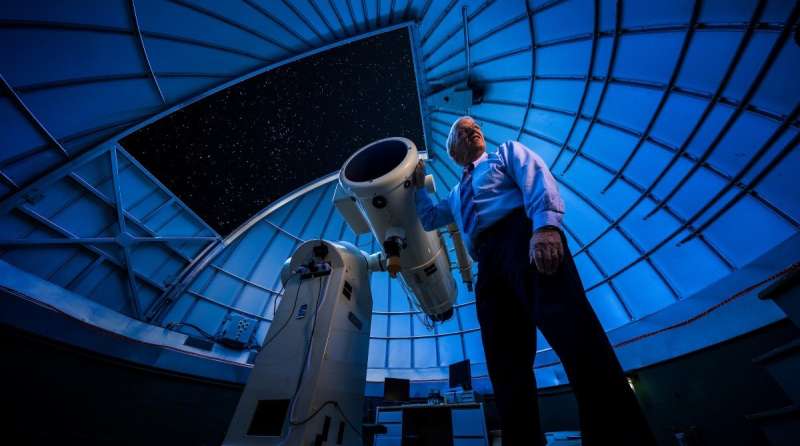Galaxy 8 billion light years away offers insight into supermassive black holes

In December 2016, what appears on digital telescopic images to be a star among stars became around 250 times brighter than usual.
Nearly 8 billion light years away, CTA 102 is a supermassive black hole surrounded by a disc of swirling matter and jets of material shooting away from it (collectively known as a blazar). And when it brightened, astronomers took note.
"In the world of astronomy, that's huge; that hardly ever happens," said J. Ward Moody, a BYU astronomy professor and member of the Whole Earth Blazar Telescope Collaboration (WEBTC). As part of the WEBTC, which recently released a paper in Nature on their CTA 102 findings, Moody captured multiple daily images of the blazar with a small optical telescope in Millard County. "When that blew like it did, it gave us the best opportunity to date to understand why blazars suddenly brighten."
And studying the blazar with the help of the light, in turn, can offer insights into how galaxies form. Most nearby galaxies have supermassive black holes at their centers. The older galaxies' black holes stand alone, having long ago absorbed or blasted out their swirling and jetting materials, and astronomers can't study black holes themselves since they don't give off light. But the black holes in younger galaxies are surrounded by materials and all sorts of high-energy physics.
"These supermassive black holes seem to be in the center of all galaxies, and we want to know why and where they come from," Moody said. "And how do you understand a black hole when it doesn't give off light itself? You study everything around it. How that material interacts with it tells us a great deal."
CTA 102's 2016 brightening (caused by a chunk of gas jetting out through a magnetic tube) also allowed researchers to explore the structure of blazars, which, because they are so far away, are only visible through photometric images as pinpointed light.
"It's detective work—very hard detective work," Moody said.
In this Nature paper, the international team of researchers, based on data collected during the ultra-light period, reveal that the jets shooting from the blazar are likely weaving instead of straight lines. As material came along the jet, it looped around and swept past astronomers' line of sight.
Moody, an astronomy aficionado since childhood, said that although the work can be painstaking, it's rewarding. "Through decades of careful research, we've been able to find out that all pinpoints of light are not the same," he said. "Some are stars, a few are these nuclei of galaxies that are billions of light years away. Just the thrill of learning how the universe is put together is what has sustained me my whole career."
Provided by Brigham Young University



















